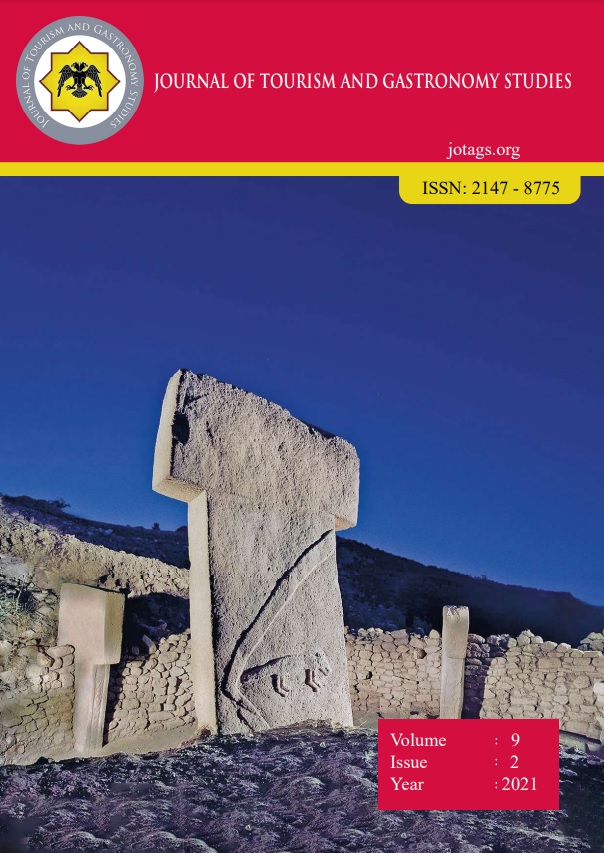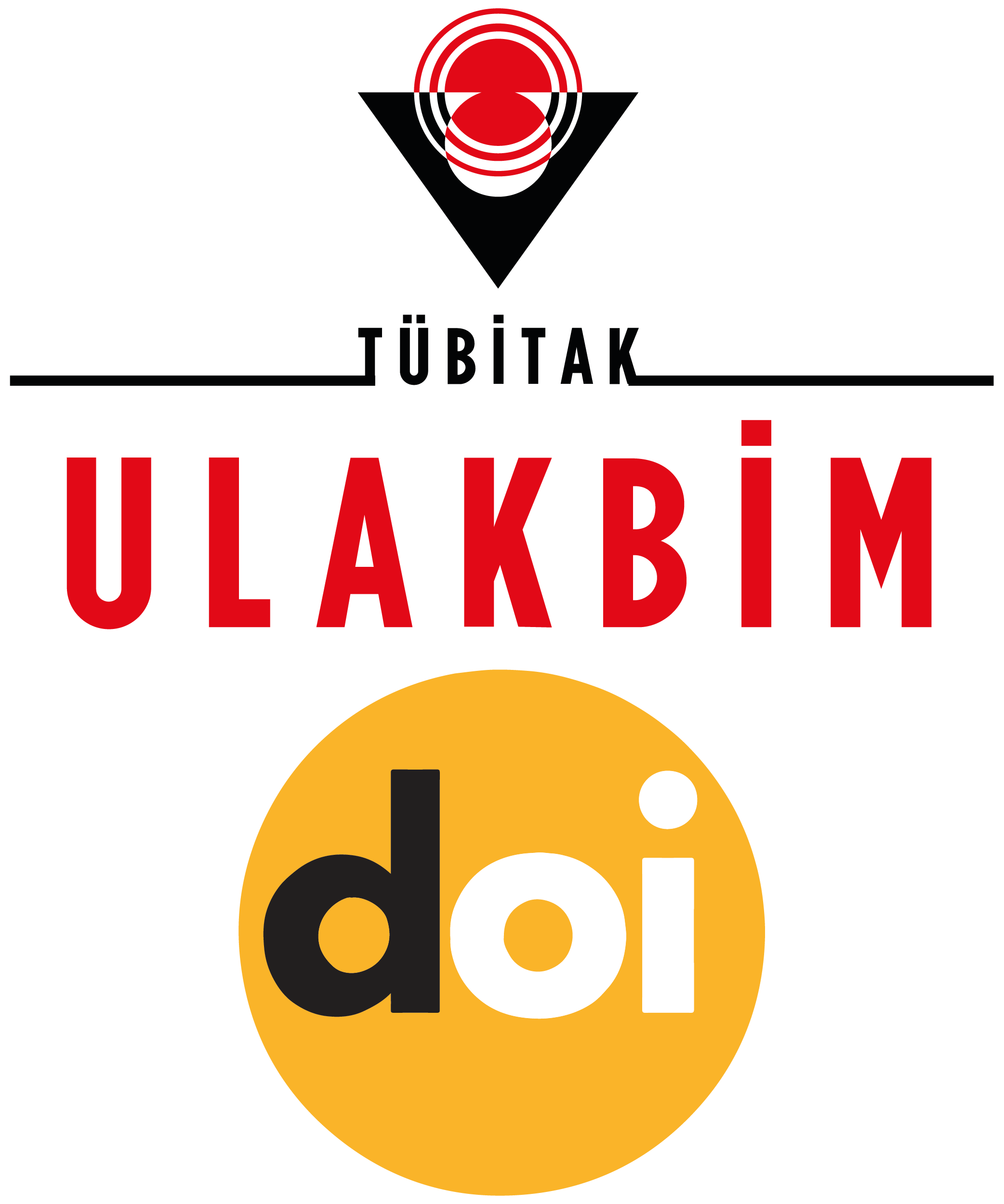Sosyal Medya’da Türk Sokak Lezzetleri: Youtube Örneği (Turkish Street Foods in Social Media: Case of Youtube)
DOI:
https://doi.org/10.21325/jotags.2021.845Keywords:
Street foods, Turkish street foods, Street foods in social media, YoutubeAbstract
It is almost impossible to separate street foods, which are perhaps the least studied subjects in the field of gastronomy, from cuisine culture. Effective use of street foods in the field of gastronomy is an important issue in terms of gastronomy tourism. With this study, it is aimed to prepare a detailed compilation of street foods. In addition, the study aimed to determine the status of Turkish street foods in the YouTube environment from the perspective of foreigners. The study prepared by using the scanning model is fictionalized on the qualitative pattern. In this context, 19 videos about "Turkish street foods" in YouTube channels, with over one million views, were analyzed and content analysis was carried out regarding them. Data for the videos were collected using YouTube Data Tools. According to the findings of the study, Turkish street foods, which are the most subjects of the videos, are, respectively, stuffed mussels, pide, honey and cream, menemen, simit, ice cream, doner, fish and bread, borek, baklava, and lahmacun. Turkish street drinks, which are the most subject of the video, are tea, ayran, pickle juice, and Turkish coffee, respectively. In terms of gastronomic tourism, street foods should be used effectively on youtube and similar video sharing platforms.
References
Adhikari, D. B. (2012). Income generation in informal sector: A case study of the street vendors of Kathmandu Metropolitan City. Economic Journal of Development Issues, 13 & 14(1–2), 1–14. doi:10.3126/ejdi.v13i0.7193
Akarçay, E. (2019). İzmir sokak lezzetleri. Meltem İzmir Akdeniz Akademisi Dergisi, (5), 106–109. doi:10.32325/iaad.2019.11
Akarçay, E., & Suğur, N. (2015). Dışarıda yemek: Eskişehir’de yeni orta sınıfın fast-food yeme-içme örüntüleri.
Sosyoloji Araştırmaları Dergisi, 18(1), 1–29. doi:10.18490/sad.19085
Allison, N., Ray, K., & Rohel, J. (2021). Mobilizing the streets: The role of food vendors in urban life. Food, Culture and Society, 24(1), 2–15. doi:10.1080/15528014.2020.1860454
Alves da Silva, S., Cardoso, R. de C. V., Góes, J. Â. W., Santos, J. N., Ramos, F. P., Bispo de Jesus, R., … Teles da Silva, P. S. (2014). Street food on the coast of Salvador, Bahia, Brazil: A study from the socioeconomic and food safety perspectives. Food Control, 40(1), 78–84. doi:10.1016/j.foodcont.2013.11.022
Aşık Akşit, N. (2019). Yerli turistlerin sokak yiyeceklerine yönelik tutumlarının belirlenmesi. Uluslararası Türk Dünyası Turizm Araştırmaları Dergisi, 4(1), 47–61.
Ballı, E. (2016). Gastronomi turizmi açısından Adana sokak lezzetleri. Journal of Tourism and Gastronomy Studies, 4(Special Issue 1), 3–17. doi:10.21325/jotags.2016.18
Baviskar, A. (2021). Street food and the art of survival: Migrants and places in Delhi, India. Food, Culture and Society, 24(1), 142–155. doi:10.1080/15528014.2020.1859903
Bektarım, N., Çakıcı, C., & Ballı, E. (2019). Sokak lezzetleri tüketim sıklığı. 3. Uluslararası Turizmin Geleceği Kongresi: İnovasyon, Girişimcilik Ve Sürdürebilirlik içinde (ss. 678–684). Mersin.
Blas-Yañez, S., Thomé-Ortiz, H., Vizcarra-Bordi, I., & Espinoza-Ortega, A. (2018). Street sale of pulque and sociospatial practices: A gender perspective in central Mexico. Journal of Ethnic Foods, 5(4), 311–316. doi:10.1016/j.jef.2018.10.005
Buscemi, S., Barile, A., Maniaci, V., Batsis, J. A., Mattina, A., & Verga, S. (2011). Characterization of street food consumption in palermo: Possible effects on health. Nutrition Journal, 10(1), 119. doi:10.1186/1475-2891-10- 119
Campbell, P. T. (2011). Assessing the knowledge, attitudes and practices of street food vendors in the city of Johannesburg regarding food hygiene and safety. University of the Western Cape.
Çavuşoğlu, M., & Çavuşoğlu, O. (2018). Gastronomi turizmi ve Kıbrıs sokak lezzetleri üzerine bir araştırma. Güncel Turizm Araştırmaları Dergisi, 2(Ek.1), 637–651.
Ceyhun Sezgin, A., & Şanlıer, N. (2016). Street food consumption in terms of the food safety and health. Journal of Human Sciences, 13(3), 4072–4083. doi:10.14687/jhs.v13i3.3925
Chukuezi, C. O. (2010). Food safety and hyienic practices of street food vendors in Owerri, Nigeria. Studies in Sociology of Science, 1(1), 50–57.
Cumhur, Ö. (2020). Sokak gıdalarının güvenliği için risk faktörlerinin değerlendirilmesi. Food and Health, 6(2), 128–139. doi:10.3153/FH20014
de la Salle, J. (2019). Great food streets: Planning and design for urban magnetism in post-agricultural cities. Urban Design International, 24(2), 118–128. doi:10.1057/s41289-019-00094-6
Demir, Ö., Avcıkurt, C., & Güleç, E. (2019). Eminönü’nde (İstanbul) balık ekmek yeme deneyimleri. Van Yüzüncü Yıl Üniversitesi Sosyal Bilimler Enstitüsü Dergisi, 1(Özel Sayı 5), 201–218.
Demir, Ş., Akdağ, G., Sormaz, Ü., & Özata, E. (2018). Sokak lezzetlerinin gastronomik değeri: İstanbul sokak lezzetleri. Güncel Turizm Araştırmaları Dergisi, 2(Ek.1), 589–601.
Dönmez Polat, D., & Gezen, A. (2017). Gastronomide sokak yiyecekleri ve satıcıları: Teorik bir çalışma. Journal of Tourism and Gastronomy Studies, 5(Özel Sayı 2), 117–124. doi:10.21325/jotags.2017.116
Duğan, Ö., & Aydın, B. O. (2018). Sosyal medyanın turizmde tanıtım amaçlı kullanımı: T.C. Kültür ve Turizm Bakanlığı örneği. Uluslararası Türk Dünyası Turizm Araştırmaları Dergisi, 3(1), 1–13.
Ehrenfeucht, R. (2017). Do food trucks and pedestrians conflict on urban streets? Journal of Urban Design, 22(2), 273–290. doi:10.1080/13574809.2017.1281731
Erşan, Y. (2020). Gastronomik ürün olarak sokak lezzetleri: İzmir sokak lezzetleri üzerine bir araştırma. Akademik Sosyal Araştırmalar Dergisi, 8(104), 353–366. doi:10.29228/asos.42846
Etwaroo, D. H., Armoogum, V., Goburdhun, D., Ruggoo, A., Dookheea, P., Thorul, H., & Noormahomed, F. Z. (2019). Level of food additives, caffeine and total sugars in locally manufactured beverages in Mauritius and their compliance with national and international norms. British Food Journal, 121(11), 2849–2866. doi:10.1108/BFJ-03-2019-0189
Farrer, J. (2021). The space-time compression of Tokyo street drinking. Food, Culture and Society, 24(1), 49–65. doi:10.1080/15528014.2020.1859902
Fusté-Forné, F. (2021). Street food in New York City: Perspectives from a holiday market. International Journal of Gastronomy and Food Science, 24(February). doi:10.1016/j.ijgfs.2021.100319
Gadaga, T. H., Zulu, R. M., Graffham, A., & Chibanda, D. (1999). Improving the safety of informally vended foods in Southern Africa – Training of Environmental Health Officers (EHO ) in Lusaka and Harare. IVF Report R8272, (January), 1–12.
Gönülgül, S., & Durlu-Özkaya, F. (2017). Los Angeles ve Toronto sokak lezzetlerinin menü içeriği ve üretim bakımından incelenmesi. Journal of Tourism and Gastronomy Studies, 5(4), 454–465. doi:10.21325/jotags.2017.160
Gözgeç, H., & Aydemir, B. (2019). Gastronomı̇de kadın sokak gıda satıcıları: Bı̇r örnek olay çalışması. MANAS Sosyal Araştırmalar Dergisi, 8(4), 3856–3870.
Gupta, V., Khanna, K., & Gupta, R. K. (2018). A study on the street food dimensions and its effects on consumer attitude and behavioural intentions. Tourism Review, 73(3), 374–388. doi:10.1108/TR-03-2018-0033
Güzeler, N., & Özbek, Ç. (2017). Conceptual analysis of street flavors of Turkey. Annals of the University of Craiova
- Agriculture, Montanology, Cadastre Series, 47(2), 147–155.
Hastaoğlu, E., Sünbül, B., & Demircioğlu, S. (2021). Sivas sokak lezzetleri ve tüketicilerin sokak lezzetlerine bakış açısı. Journal of Tourism and Gastronomy Studies, 9(1), 299–313. doi:10.21325/jotags.2021.790
Hayden, T. B. (2021). Street food as infrastructure: Consumer mobility, vendor removability and food security in Mexico City. Food, Culture and Society, 24(1), 98–111. doi:10.1080/15528014.2020.1859920
Hill, J., Mchiza, Z., Puoane, T., & Steyn, N. P. (2019). Food sold by street-food vendors in Cape Town and surrounding areas: A focus on food and nutrition knowledge as well as practices related to food preparation of street-food vendors. Journal of Hunger and Environmental Nutrition, 14(3), 401–415. doi:10.1080/19320248.2018.1434104
İrigüler, F., & Öztürk, B. (2016). Street food as a gastronomic tool in Turkey. II. International Gastronomic Tourism Congress içinde (ss. 49–64). İzmir.
Isabel Míguez-González, M. (2017). YouTube usage by Spanish tourist destinations as a tool to communicate their identities and brands. Journal of Brand Management, 24, 211–229. doi:10.1057/s41262-017-0031-y
Kanık, İ. (2016). Gatro medya ve gastro kültürün kavramsal incelemesi. Folklor/Edebiyat, 22(88), 83–98.
Kargiglioğlu, Ş., & Aksoy, M. (2019). Sokak lezzetlerini tatma amacıyla İstanbul’u ziyaret eden turistlerin İstanbul seyahatlerinin değerlendirilmesine yönelik bir araştırma. Journal of Tourism and Gastronomy Studies, 7(3), 1821–1835. doi:10.21325/jotags.2019.450
Karsavuran, Z. (2018). Sokak yemekleri: Farklı disiplinlerin yaklaşımı ve gastronomi turizmi alanında sokak yemeklerinin değerlendirilmesi. Journal of Tourism and Gastronomy Studies, 6(1), 246–265. doi:10.21325/jotags.2018.185
Kok, R., & Balkaran, R. (2014). Street food vending and hygiene practices and implications for consumers. Journal of Economics and Behavioral Studies, 6(3), 188–193. doi:10.22610/jebs.v6i3.482
Kotval-K, Z. (2020). Food networks and urban informality in Mumbai, India. British Food Journal, 123(2), 771– 788. doi:10.1108/BFJ-02-2020-0119
Li, M., Yan, S., Yang, D., & Cui, W. (2019). YouTubeTM as a source of information on food poisoning. BMC Public Health, 19, 952. doi:10.1186/s12889-019-7297 9
Marras, S. R. (2014). Comparative Analysis of Legislative Approaches to Street Food in South American Metropolises. R. De Cassia Vieria Cardoso, M. Companion ve S. R. Marras (Ed.), Street Food: Culture, Economy, Health and Governance içinde (ss. 15–45).
Morano, R. S., Barrichello, A., Jacomossi, R. R., & D’Acosta-Rivera, J. R. (2018). Street food: Factors influencing perception of product quality. RAUSP Management Journal, 53(4), 535–554. doi:10.1108/RAUSP-06-2018- 0032
Oğuz, S. (2020). Sokak yemeklerı̇nden yı̇yecek bölgelerı̇ne - Kentsel mekânda gastronomi hı̇zmetlerı̇ ve mutfak turı̇zmı̇: Adana örneğı̇. Artıbilim Adana Alparslan Türkeş Bilim ve Teknoloji Üniversitesi Sosyal Bilimler Dergisi, 3(2), 0–0.
Okumus, B., Sönmez, S., Moore, S., Auvil, D. P., & Parks, G. D. (2019). Exploring safety of food truck products in a developed country. International Journal of Hospitality Management, 81(April), 150–158. doi:10.1016/j.ijhm.2019.02.011
Omemu, A. M., & Aderoju, S. T. (2008). Food safety knowledge and practices of street food vendors in the city of Abeokuta, Nigeria. Food Control, 19(4), 396–402. doi:10.1016/j.foodcont.2007.04.021
Öney Tan, A. (2013). Turkey. B. Kraig ve C. Taylor Sen (Ed.), Street Food around the World: An Encyclopedia of Food and Culture içinde (ss. 357–366). ABC-CLIO.
Özaltın Türker, G. (2020). Covid-19 salgını turizm sektörünü nasıl etkiler? Turizm akademisyenleri perspektifinden bir değerlendirme. International Journal of Social Sciences and Education Research, 6(2), 207–224.
Özbay, G. (2020). Ulusal ve uluslararası platformda gastronomik kimlik unsuru olarak simit. Journal of Tourism and Gastronomy Studies, 8(1), 670–683. doi:10.21325/jotags.2020.571
Parasecoli, F. (2021). Eating on the go in Italy: Between cibo di strada and street food. Food, Culture and Society, 24(1), 112–126. doi:10.1080/15528014.2020.1859901
Pişkin, H. N. (2011). Fast food kargaşası üzerine bir değerlendirme: Bir gün gelecek herkes hamburger mi yiyecek? Sosyologca, 1(2), 237–246.
Privitera, D., & Nesci, F. S. (2015). Globalization vs. local. The role of street food in the urban food system. Procedia Economics and Finance, 22, 716–722. doi:10.1016/s2212-5671(15)00292-0
Proietti, I., Frazzoli, C., & Mantovani, A. (2014). Identification and management of toxicological hazards of street foods in developing countries. Food and Chemical Toxicology, 63, 143–152. doi:10.1016/j.fct.2013.10.047
Renwick, T. (2021). Jay Fai and the anomaly of the “good” street vendor. Food, Culture and Society, 24(1), 127–141. doi:10.1080/15528014.2020.1860442
Rieder, B. (2015). YouTube data tools.
Şahin, E., & Solunoğlu, A. (2019). Planlı davranış teorisi kapsamında sokak yemeği yeme niyetinin ölçülmesi: Mersin örneği. Seyahat ve Otel İşletmeciliği Dergisi, 16(3), 383–397.
Salvador, M. S. (2019). Shaping the city through food: The historic foodscape of Lisbon as case study. Urban Design International, 24(2), 80–93. doi:10.1057/s41289-019-00084-8
Sert, S., & Kapusuz, F. (2010). Açıkta satılan gıdalar: Öğrencilerin görüşleri ve tercih etme nedenleri üzerine bir araştırma. Gıda Teknolojileri Elektronik Dergisi, 5(3), 25–35.
Sharma, J. (2021). Food cries, historical city sounds, and the twentieth century silencing of street vendors. Food, Culture and Society, 24(1), 16–30. doi:10.1080/15528014.2020.1859923
Shaw, M. (2019). Halal versus Hipster: The struggle for Sydney road and the culture of complaint. Journal of Islamic Marketing, 11(6), 1485–1496. doi:10.1108/JIMA-03-2019-0045
Song, H., & Kim, J.-H. (2021). The cause-effect relationship between negative food incidents and tourists’ negative emotions. International Journal of Hospitality Management, 95(December 2019), 102925. doi:10.1016/j.ijhm.2021.102925
Sotiriadis, M. D. (2017). Sharing tourism experiences in social media: A literature review and a set of suggested business strategies. International Journal of Contemporary Hospitality Management, 29(1), 179–225. doi:10.1108/IJCHM-05-2016-0300
Soylu, A. G., Taştan, H., Katranbayırı, F., & Aslantürk, E. (2021). Tüketicilerin sokak lezzetlerine yaklaşımlarının neofobi tutumları açısından değerlendirilmesi. Safran Kültür ve Turizm Araştırmaları Dergisi, 4(1), 151–167.
Steyn, N. P., & Labadarios, D. (2011). Street foods and fast foods: How much do South Africans of different ethnic groups consume? Ethnicity and Disease, 21(4), 462–466.
Sujatha, T., Shatrugna, V., Rao, G. V. N., Chenna, G., Reddy, K., Padmavathi, K. S., & Vidyasagar, P. (1997). Street food: An important source of energy for the urban worker. Food and Nutrition Bulletin (C. 18).
Sünnetçioğlu, S., & Yıldırım, H. M. (2019). Sokak yiyeceklerinin tüketiminde satıcıya olan güven, algılanan risk, algılanan fayda, tutum ve satın alma niyeti arasındaki ilişkilerin incelenmesi. MANAS Sosyal Araştırmalar Dergisi, 8(3), 2799–2818. doi:10.33206/mjss.481779
Tarınç, A. (2019). Avrupa ve Türkiye’deki sokak tatlılarının karşılaştırılması. Turizm temelleri: Kültürel değerler, pazarlama ve iletişim içinde (ss. 27–59). Ankara: IKSAD Publishing.
Tavşancıl, E., & Aslan, E. (2001). Sözel, yazılı ve dDiğer materyaller için içerik analizi ve uygulama örnekleri.
İstanbul: Epilson Yayınları.
Tinker, I. (1999). Street foods into the 21st century. Agriculture and Human Values, 16(3), 327–333. doi:10.1023/A:1007569728512
Toh, P. S., & Birchenough, A. (2000). Food safety knowledge and attitudes: Culture and environment impact on hawkers in Malaysia.: Knowledge and attitudes are key attributes of concern in hawker foodhandling practices and outbreaks of food poisoning and their prevention. Food Control, 11(6), 447–452. doi:10.1016/S0956- 7135(00)00008-6
Torres Chavarria, L. C., & Phakdee-auksorn, P. (2017). Understanding international tourists’ attitudes towards street food in Phuket, Thailand. Tourism Management Perspectives, 21, 66–73. doi:10.1016/j.tmp.2016.11.005
Tuten, T. L., & Solomon, M. R. (2018). Social Media Marketing (3. bs.). Los Angeles: SAGE.
Ünal, A., & İpar, M. S. (2020). Destinasyon pazarlamasının bir bileşeni olarak sokak lezzetlerinin değerlendirilmesi: İzmir örneği. Kafkas Universitesi Sosyal Bilimler Enstitüsü Dergisi, (26), 843–863. doi:10.9775/kausbed.2020.043
Ünal Turhan, E., Demir, H., Püsküllü, R., Kör, M., & Zengin, U. (2020). Sokakta satışa sunulan geleneksel Kadirli sucuğunun mikrobiyolojik kalitesi. Food and Health, 6(1), 27–34. doi:10.3153/FH20004
Wirakartakusumah, A., Purnomo, E. H., & Dewanti-Hariyadi, R. (2014). Safety of street food: Indonesia’s experience. Encyclopedia of Agriculture and Food Systems, 75–79. doi:10.1016/B978-0-444-52512-3.00051-6
Yayla, Ö., Sandıkcı, M., & Çavuşoğlu, M. (2014). The effect of social media on buying decision process of tourists.
C. Çobanoğlu ve S. Ongan (Ed.), International Interdisciplinary Business-Economics Advancement Conference içinde (ss. 282–287). İstanbul: ANAHEI.
Yeap, J. A. L., Ong, K. S. G., Yapp, E. H. T., & Ooi, S. K. (2020). Hungry for more: Understanding young domestic travellers’ return for Penang street food. British Food Journal, 122(6), 1935–1952. doi:10.1108/BFJ-09-2018- 0632
Yıldırım, A., & Şimşek, H. (2013). Sosyal bilimlerde nitel araştırma yöntemleri. Ankara: Seçkin Yayıncılık.
Yıldırım, Ö., & Albayrak, A. (2019). Yabancı turistlerin İstanbul sokak yemeklerini değerlendirmeleri üzerine bir çalışma. Journal of Tourism and Gastronomy Studies, 7(2), 1077–1092. doi:10.21325/jotags.2019.409
Youtube About (2021). https://www.youtube.com/intl/en-GB/about/press/ adresinden erişildi.
Zainol, Z., Yahaya, R., Osman, J., & Omar, N. A. (2019). Application of the Tayyib concept among Malaysian muslim consumers: The role of nutrition label. Journal of Islamic Marketing, 11(3), 819–840. doi:10.1108/JIMA- 03-2018-0048
Zencir, E., & Bayraktar, G. (2019). Sokak satıcılarının gözünden sokak lezzetleri: İzmir örneği. Journal of Tourism and Gastronomy Studies, 7(2), 1367–1382. doi:10.21325/jotags.2019.425
Downloads
Published
How to Cite
Issue
Section
License
Copyright (c) 2023 Journal of Tourism & Gastronomy Studies

This work is licensed under a Creative Commons Attribution-NonCommercial 4.0 International License.








